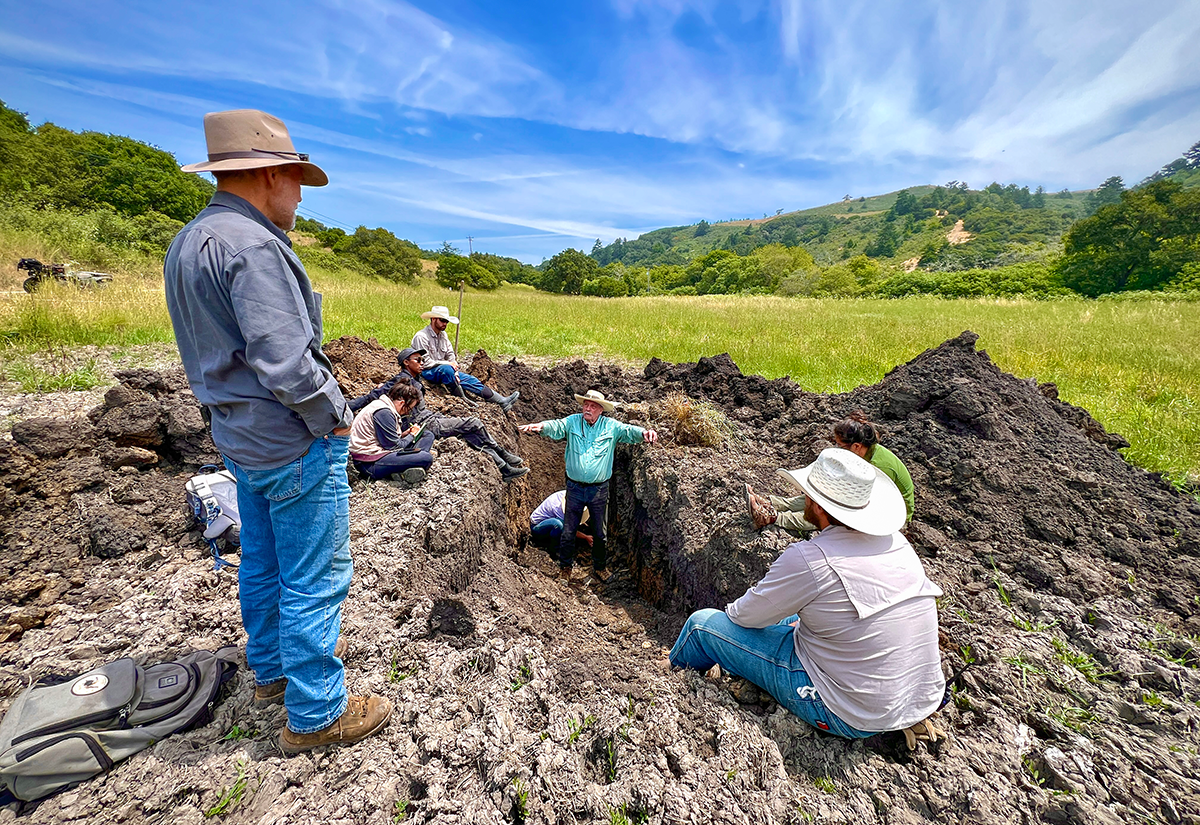In our last article, we shared land management success stories from around the world. We now turn our attention to practical questions about implementing regenerative land strategies…
Where Restoration Meets Management – Implementing Regenerative Land Management at TomKat and Beyond

Wendell Gilgert, standing in a trench, describes the various soil types found at TomKat Ranch
06/23/2025
This is the second of a three part series about restoring land through regenerative land management.
By: By Wendy Millet and Mark Biaggi
In our last article, we shared land management success stories from around the world. We now turn our attention to practical questions about implementing regenerative land strategies in an agricultural context. How do we restore soil, water, and energy cycles while stewarding the land for healthy food? How do we break from old paradigms and try something new in the name of restoring the land, water, and soil?
The process of implementing regenerative practices begins with shifting our paradigm as land managers from the notion that nature is a collection of parts that fit together in a linear fashion which can be controlled and fixed as one would a machine, towards a paradigm based on understanding our role as observers, collaborators, and partners with nature.
Every landbase (soils, ecology, weather, land use history, etc) around the world is different and thus regenerative solutions require trial and error informed by what nature has set up to thrive in that particular place. Centuries of farming and land management practices that prioritized using the land (both the food and fiber) without giving back any resources has led to ecological degradation, topsoil loss, and biodiversity collapse we see on landscapes around the world.
Today’s regenerative movement represents a fundamental shift towards restoring ecological function for the benefit of people and the planet. Understanding regenerative management requires a profound re-understanding of the importance of soil—not as an inert growing medium, but as a complex living ecosystem. A single teaspoon of healthy soil contains more microorganisms than there are people on the planet. This underground ecosystem forms the base of the terrestrial food web and mediates virtually all soil processes essential to the health of plants, animals, humans, air, water, and our climate.

Where soil is the foundation of nature, water is what enlivens it. In healthy ecosystems, rainfall infiltrates deeply into the ground where it’s stored and slowly released. By contrast, degraded landscapes shed water (often rapidly), leading to flooding and erosion, and contributing to drought as ineffective rainfall fails to recharge local hydrological systems. Regenerative practices aim to ensure “effective rainfall” (water that infiltrates the soil and stays in the land where it falls). Through increasing soil organic matter, strategic revegetation, and managing grazing patterns, areas once plagued by floods and droughts may improve hydrological cycles, and even see the return of springs that had been dry for generations.
To integrate regenerative principles into land management in a new place, safe-to-fail trials can be a big help. Designed to be context-specific and low-risk, safe-to-fail experiments can happen on small areas to address a specific resource concern or test a potential solution. These trials can serve as the starting point for more extensive implementation of regenerative practices once the practitioner has a chance to refine their approach.
One safe-to-fail trial at TomKat Ranch has been bale grazing. We strategically placed hay bales in areas with poor soil health or erosion issues due to legacy farming. While the ground was hard and dry and concentrated with livestock, we applied a carpet of biological material made of hay, dung and urine. As a result, we have seen a tremendous increase in biomass and a 500-600% improvement in water infiltration that continues to have a positive impact 5 years later. What began as a simple experiment has evolved into a practice that can rejuvenate struggling pastures. It’s not a tool we use everywhere, but this safe-to-fail trial is now one approach that can help us address certain resource-constrained areas on our ranch.
Our riparian grazing trials have been equally enlightening. We initially wondered if livestock could help manage overgrown vegetation in our riparian areas without negatively impacting the aquatic and bird populations who call those areas home. By controlling the timing, density, and seasons we graze, we have seen how livestock effectively graze and trample decadent vegetation, creating space for greater biodiversity along our waterways. Guided by our understanding of how riparian systems evolved historically—herds of wildlife moved quickly in and out to avoid predator‚we seek to manage our herd in ways that mimic these natural cycles of disturbance.
In our ongoing journey to learn how to regenerate the lands in our care, perhaps the most important lesson every day is humility. Every season brings new insights that challenge our assumptions and deepen our understanding. We’ve learned to observe more carefully, to question our interventions, and to recognize that we are not commanders of the land but students of it. Even our “failures” provide valuable feedback, guiding us toward more effective approaches. Sometimes a higher disturbance or longer rest than deemed appropriate has created optimal conditions for increasing biodiversity. As we continue this work, we remain profoundly aware that regenerative management is not a destination but a continuous process of learning, adapting, and growing alongside, and as one with, the living systems we steward.